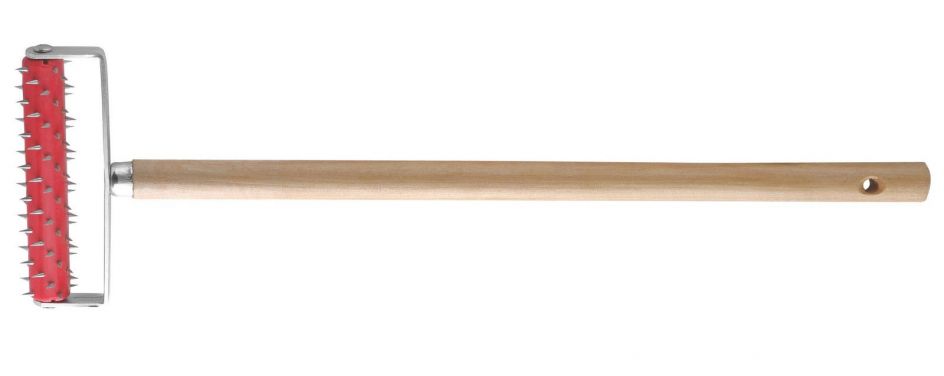The wallpaper perforator, which is also known as a spiked roller or perforating roller, is a typical and immensely useful tool for removing paper-based wallpapers. It is used in conjunction with, or prior to, the wallpaper spatula to ensure that soapy water can permeate the wallpaper layers more easily so that removing the wallpaper becomes less of an effort. The wallpaper perforator also gives you better access to the sublayers of painted-over or sealed wallpapers.
Excursion: Removing paper-based wallpapers
With regard to subsequent removal, there are two categories of paper-based wallpapers: "easy to remove" and "dry stripping". Dry stripping means that the top wallpaper layer (decorative layer) can be easily removed from the wall, usually without any support, while the bottom or carrier layer remains on the wall. The latter has to be removed by soaking it and scraping it off. Depending on the state it is in, the bottom layer might be left on the wall as lining.
Removing wet-strippable wallpapers or a lining layer infused with stubborn wallpaper paste (e.g. due to highly absorbent wall surfaces) by means of wetting, soaking and scraping is a Sisyphean tasks which can easily bring DIY and wallpapering enthusiasts to the verge of despair. The wallpaper perforator is an ideal tool in these situations. It perforates the surface of the wallpaper and thus ensures that soapy water or the wallpaper remover is able to better permeate the solid layer and dissolve the wallpaper paste.
The wallpaper perforator and its commercial designs
In specialist painting and decorating shops, DIY stores and on online marketplaces, the wallpaper perforator is available in two designs: straight and V-shaped. This difference relates to the specific shape of the roll.
The straight wallpaper perforator consists of a plastic or brass roll with steel spikes all over, a stainless steel handle bracket and the actual handle (grip), which is made from wood or plastic. To ensure that you can reach up the entire wall when perforating the paper, the roll handle is extra-long. Handles can be differentiated as follows: wooden handles that are up to 50 cm long, and plastic handles with an expandable telescopic pole whose length can be set to between 50 and 100 cm as required.

The roll is between 15 and 20 cm wide and available in different colours, depending on the provider/manufacturer. Popular colours include black, grey, yellow, red and blue. Prices for the wallpaper perforator vary greatly, depending on the roll material and handle design.
The V-shaped wallpaper perforator comes with a wooden handle by default. At the bottom end of the handle is a galvanised bracket construction with brass spike-tooth rollers attached on both sides at an angle (V-shape). Each of these rollers measures 7.5 cm. This type of wallpaper perforator is considerably pricier than the straight version.

There are no general purchase recommendations. You simply need to test the models to establish which one works best for you. The V-shaped wallpaper perforator has also been designed for hard-to-reach areas. Brass rollers offer great resistance and last a very long time. Telescopic poles can be expanded in line with your height and the areas to be treated. This makes them very convenient to use without the need for ladders.
The connecting elements between the handle and the rollers definitely should be stable and secure. There is nothing worse than working with a wobbly handle or one that frequently comes out of its bracket.
How to use the wallpaper perforator
The wallpaper perforator is used on dry wallpaper. It should be guided across the wall in quick rolling movements. We recommend working in strips, first horizontally, then vertically and diagonally. Apply pressure carefully as the steel spikes could leave holes or marks on the wall surface. Having finished with the perforator, you need to apply a mix of warm water and detergent/commercial wallpaper remover using a spray bottle, role or brush. Leave it to soak for 10 to 20 minutes and remove the wallpaper using the scraping spatula. You should push the spatula under the seam to begin removing a strip of wallpaper.
To prevent the wallpaper from drying too quickly, the room should not be too warm. As with any tool, we recommend cleaning the wallpaper perforator after use, in particular the steel spikes and the roll(s).

